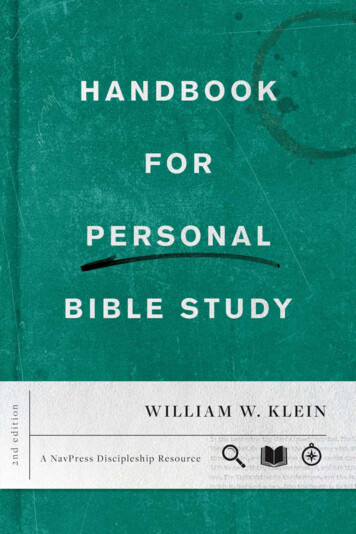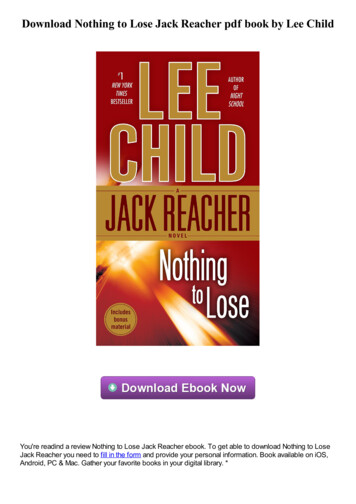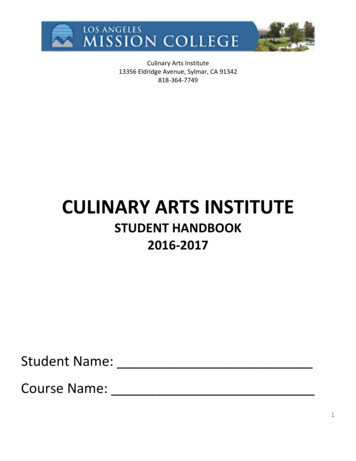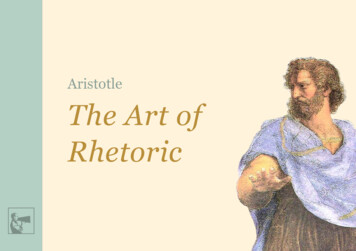
Transcription
There’s nothing more exciting than seeing a person become interested—really interested—in the Bible for the first time. But getting started in arelationship with God through his Word can easily become frustratingand overwhelming. In Handbook for Personal Bible Study, William Kleingives us a concise, relatable field guide to the foundational purpose andpractice of Bible study. Every pastor, disciplemaker, and new Christianwill benefit from having this book on their shelf.REV. NICOLE UNICE, pastor, host of How to Study the Bible podcast, and authorof Help! My Bible Is Alive!The Bible was written for us, but it wasn’t written to us. Though wereadily understand we’re not Israelites living thousands of years ago,we commonly forget this important fact . . . and because of it, studyingthe Scriptures can feel daunting and confusing. Thankfully, books likethe Handbook for Personal Bible Study give us tools to dive in withoutour eyes glazing over and our heads spinning. From understandingwhy various versions are translated (and for what purpose) to learningto delve into the ever-important historical and cultural backgroundsurrounding a passage, Klein gives us insight and methods to live a lifeof wisdom that isn’t spoon-fed to us from others but given straight fromthe Bible itself.TERESA SWANSTROM ANDERSON, author of the Get Wisdom BibleStudy series
Handbook for Personal Bible Study2nd editionWilliam W. KleinNavPressW I L L I A M W. K L E I NA NavPress resource published in alliancewith Tyndale House Publishers
NavPress is the publishing ministry of The Navigators, an international Christianorganization and leader in personal spiritual development. NavPress is committed tohelping people grow spiritually and enjoy lives of meaning and hope through personaland group resources that are b iblically rooted, culturally relevant, and highly practical.For more information, visit NavPress.com.Handbook for Personal Bible StudyFirst edition 2008 by Dr. William W. Klein. Revised edition 2021 by William W. Klein. All rightsreserved.A NavPress resource published in alliance with Tyndale House Publishers.NavPress and the NavPress logo are registered trademarks of NavPress, The Navigators, Colorado Springs,CO. Tyndale is a registered trademark of Tyndale House Ministries. Absence of in connection with marksof NavPress or other parties does not indicate an absence of registration of those marks.The Team: David Zimmerman, Acquisitions Editor; Deborah Howell, Copy Editor; Olivia Eldredge,Operations Manager; Julie Chen, DesignerUnless otherwise noted, cover images are from Adobe Stock and the property of their respective copyrightholders, and all rights are reserved. Book icon Graficriver; compass icon Vector Icons; magnifiericon vectorchef; marker swoosh by Julie Chen Tyndale House Ministries; coffee stains KsushaArt/Shutterstock; paper texture Zeppelin Graphic/Design Cuts; grunge texture Kim Klaassen/Design Cuts.Author photo taken by Ben Crenshaw, copyright 2013. All rights reserved.All Scripture quotations, unless otherwise indicated, are taken from the Holy Bible, New InternationalVersion, NIV. Copyright 1973, 1978, 1984, 2011 by Biblica, Inc. Used by permission. All rightsreserved worldwide. Scripture quotations marked CEB are taken from the Common English Bible, copyright2011. Used by permission. All rights reserved. Scripture quotations marked CSB are taken from the ChristianStandard Bible , copyright 2017 by Holman Bible Publishers. Used by permission. Christian StandardBible and CSB are federally registered trademarks of Holman Bible Publishers. Scripture quotations markedESV are from The ESV Bible (The Holy Bible, English Standard Version ), copyright 2001 by Crossway,a publishing ministry of Good News Publishers. Used by permission. All rights reserved. Scripture quotationsmarked KJV are taken from the Holy Bible, King James Version. Scripture quotations marked MSG are takenfrom The Message, copyright 1993, 2002, 2018 by Eugene H. Peterson. Used by permission of NavPress.All rights reserved. Represented by Tyndale House Publishers. Scripture quotations marked NASB are takenfrom the (NASB ) New American Standard Bible, copyright 1960, 1971, 1977, 1995, 2020 by TheLockman Foundation. Used by permission. All rights reserved. www.lockman.org. Scripture quotationsmarked NKJV are taken from the New King James Version, copyright 1982 by Thomas Nelson. Used bypermission. All rights reserved. Scripture quotations marked NLT are taken from the Holy Bible, New LivingTranslation, copyright 1996, 2004, 2015 by Tyndale House Foundation. Used by permission of TyndaleHouse Publishers, Carol Stream, Illinois 60188. All rights reserved. Scripture quotations marked NRSV aretaken from the New Revised Standard Version Bible, copyright 1989 National Council of the Churches ofChrist in the United States of America. Used by permission. All rights reserved worldwide.Excerpts from Discipleship Journal are used by permission of The Navigators. All rights reserved.Excerpts from The Navigator Bible Studies Handbook 1974, 1979, 1994 by The Navigators are used bypermission of NavPress, represented by Tyndale House Publishers. All rights reserved.Some of the anecdotal illustrations in this book are true to life and are included with the permission of thepersons involved. All other illustrations are composites of real situations, and any resemblance to peopleliving or dead is purely coincidental.For information about special discounts for bulk purchases, please contact Tyndale House Publishers atcsresponse@tyndale.com, or call 1-855-277-9400.ISBN 978-1-64158-268-1Printed in the United States of America277266255244233222211
CONTENTSPreface ixAcknowledgments xiIntroduction 1PART ONE: THE BIBLEC h a p t e r 1 : How the Bible Came to Us 7C h a p t e r 2 : The Spiritual Discipline of Bible Intake 37C h a p t e r 3 : Interpreting the Bible 59C h a p t e r 4 : Preparing to Study the Bible: Its Story and World 115PART TWO: BIBLE STUDYC h a p t e r 5 : The Basics of Bible Study 143C h a p t e r 6 : Basic Bible Study Methods 161C h a p t e r 7 : In- Depth Bible Study Methods 193C h a p t e r 8 : Uses of the Bible 221C h a p t e r 9 : A Lifetime of Bible Study 245A p p e n d i x : Resources and Helps for Studying the Bible 255Abbreviations 264Notes 265Author 269Index 271
PrefaceThe Bible has always occupied a central place in my life. When I was growing up, my parents were members of churches that preached and taught theBible. At the early age of seven, I decided to follow Jesus myself— with theencouragement of a children’s Bible teacher. My mother was an outstanding lay Bible scholar, effectively teaching children and adults throughouther life in the days when conservative churches didn’t always encouragewomen to be teachers.I took Bible courses in college and attended seminary after that. Upongraduation with a master of divinity degree, I served on the staff of a largechurch in California. Teaching the Bible became the central focus of myministry. At first, among other pastoral duties, I taught classes and led small- group Bible studies for college students, single adults, and young couples.Then, as minister of evangelism and discipleship, I focused more exclusivelyon teaching and overseeing small groups for the entire church. I recruitedand trained many small- group Bible study leaders over several years. I developed curricula and Bible studies. The teaching bug really bit me!I then acquired a PhD in New Testament exegesis and have been teaching courses related to the New Testament ever since. That has includedcourses in biblical interpretation and Greek exegesis, as well as courses thatsurveyed the New Testament or focused on specific books within it. Inaddition to teaching undergraduate and graduate courses, I remain stronglycommitted to the local church, and I’ve had many opportunities to teachclasses and lead Bible studies of various kinds throughout the years.I’m telling you this bit of personal history not to call attention to myselfix
x HANDBOOK FOR PERSONAL BIBLE STUDYin some narcissistic way, but to emphasize this point: God has blessed mylife with profound and life- giving connections to Scripture. I’ve come todeeply value the study of God’s Word. It has the power to transform lives.I’ve seen it happen repeatedly— in my own life and in the lives of others.Why study the Scriptures? With great insight, the writer of Hebrewspenned these words: “For the word of God is alive and active. Sharper thanany double- edged sword, it penetrates even to dividing soul and spirit,joints and marrow; it judges the thoughts and attitudes of the heart” (4:12).While this text does not limit God’s “word” to the Bible, certainly we canhear God speaking through it. Not only can God’s Word discern who weare, but God can use it to transform us to become what God intends usto be. As the apostle Paul put it, “Every part of Scripture is God- breathedand useful one way or a nother— showing us truth, exposing our rebellion, correct ing our mistakes, training us to live God’s way. Through theWord we are put together and shaped up for the tasks God has for us”(2 Tim 3:16-17, msg). What a resource! God has given us a great treasurein Scripture. Who wouldn’t want to be a student of the Bible?In addition to the printed page, now we’re blessed to have all typesof new and convenient ways to access the Bible. In the kitchen or at theoffice, with a laptop, tablet, phone, or desktop computer, we have manyprograms and websites that put Scriptures on our screens and allow for allkinds of study. In church, when a preacher or teacher says, “Open up yourBibles,” many pick up their phones or tablets to find the text (“Turn onyour Bible app!”). These electronic devices enable us to access Scripturefrom planes, coffee shops, or park benches— and we can shove them backinto our pocket, backpack, or purse when we’re finished.I’m certainly not saying that God limits his working in the world to theBible and to those who have access to it. However, the Bible serves as thecenterpiece of God’s special revelation. We’re blessed to have God’s Word,and when we engage it seriously, God accomplishes extraordinary things!My fondest hope is that this Handbook for Personal Bible Study, now in thissecond and revised edition, will encourage many people to embrace theBible, for the first time or perhaps in new ways, as God’s living and activemessage to them. That’s my hope and prayer for you— that your readingand studying of God’s Word will enable you to encounter the living Godin both fresh and profound ways.
AcknowledgmentsI want to thank and acknowledge several people for their roles inbringing me to a love for Scripture and its Author. These individuals setme on a course that enables me to write this book. My parents, Williamand Eleanor Klein, were committed to the Bible, and my mother modeledserious study from my earliest days. Sadly, I don’t know the name of thewoman who led me to “take Jesus as my Savior,” but I thank her for helping me to make that decision and for giving me my first copy of the NewTestament. Dr. Charles W. Anderson, my pastor during my teen years,helped me see how vital and l ife- changing Scripture can be. These people,along with faithful Sunday school teachers and youth leaders, laid a surefoundation for my life.My love for and competence in the Scriptures was abetted by coursesin the Bible and the biblical languages that I took at Wheaton Collegeand Denver Seminary. Special mention goes to Dr. Gerald Hawthorne atWheaton and Dr. Donald Burdick at Denver. They were inspiring teacherswho modeled that profession for me. Thanks also to many people who’vegiven me the privilege to teach or lead them in Bible studies in churches,campus groups, and other venues.I acknowledge the contributions of many generations of students I havetaught at Denver Seminary. In both New Testament courses and my e very- semester course in biblical interpretation, I had the privilege of seeing theirlove for Scripture grow and their competence in Bible analysis and exegesisblossom. What an encouragement to me, and a source of hope for thefuture of Christian witness in the world!xi
xii HANDBOOK FOR PERSONAL BIBLE STUDYI also acknowledge the support of Kent Wilson of NavPress, who initially pursued me to undertake the first edition of this project, and publisher Don Pape, who expressed enough enthusiasm for the book to warranta second edition. Affirming the Navigators’ long history of commitmentto Bible study and publishing Bible study aids (some of which are reflectedin these pages), these publishers wanted to place in one volume resourcesthat would help and encourage people to continue that crucial pursuit.In addition, I want to acknowledge the efforts of two editors. In the firstedition, Brad Lewis helped convert my sometimes elevated or obtuse proseinto more readable sentences. For this revised edition, David Zimmerman’ssuggestions helped me streamline the work into this more useful form, andDeborah Howell did a superb job as copy editor. Their observations werealways astute and helped focus my attention to the needs of readers today.Finally, I acknowledge the constant encouragement of my dear wife,Phyllis. Her spiritual strength and vitality are sustaining graces in my spiritual journey. She is a loving mother and grandmother. She supports manyothers through her friendships and her ministry of spiritual direction. Hercommitment to prayer and cultivating the life with God inspire my own( often- too- feeble) efforts.William W. KleinColumbine Valley, Colorado
IntroductionPerhaps you’ve seen books on “how to study the Bible” in bookstores oronline booksellers, and perhaps you even have some on your own shelves.Some provide theoretical help in the task of understanding God’s Word,while others strive to be practical and h ands- on. Some pastors write fromtheir perspectives in the church, while others instruct readers from theirvantage points in various parachurch ministries or academic institutions.Many of them are excellent, helpful, and encouraging.So why do I presume to write yet another book to add to the stack?While other authors address specific elements to help Christians study theBible, no one provides the scope of coverage that I’m offering here. Ofcourse, it easily could have been much larger. Still, you’ll find that it covers more territory than most books that provide specific and more limitedinstruction on how to study the Bible.Let me highlight several features that motivated my writing. MostChristians need encouragement to persevere in their engagement with theBible. While we want to understand why the Bible is important for ourlives, we also want and need practical and concrete help on how to conductour study— and to keep at it. Because we all come in different shapes andsizes (culture, gender, race, denomination, and other factors), because wehave been on the journey for longer or shorter times, and because we’remore or less familiar with the Bible and the Christian faith, we need different approaches and tactics that will serve us well. Furthermore, thoseapproaches and tactics might need to change as our faith grows and as timein our schedules allows.1
2 HANDBOOK FOR PERSONAL BIBLE STUDYWhile no one book can supply everything you might want or need forstudying the Bible, my goal is to provide as much help as possible withina reasonably sized volume. Here is a book that individuals can use profitably on their own, and that small groups could also find useful to answerspecific questions before they go too far into their study. I’ve designed it tobe practical and readable while not “talking down” to anyone. It portraysthe best tactics for understanding the Bible and gives readers suggestionsto study specific issues in more depth on their own.All of this means that you might read some sections or chapters onlyonce but return to other parts repeatedly as you seek more help or furtherinsight, or to refresh your memory about certain ideas. You’ll discover abit of overlap in several chapters, as I need to say similar things in different ways or from different perspectives. If you find that some conceptsseem familiar, you can skim through those rapidly until you encounternew territory. I might cover some points briefly in one place and thenin more detail in another. You can return to the fuller explanation if youneed a refresher.So, what does the book include? Let’s briefly look at what each chaptercontains.Chapter 1 sets the stage for reading and studying the Bible. It helps usunderstand the nature of the Bible and how it came to us by way of theancient Hebrew and early Christian communities. We also answer questions such as: Why do we have so many versions and translations availabletoday? Can we trust some or all of them? And why do some Christiangroups but not others include the Apocrypha in their Bibles?Chapter 2 points us to our need to take in the message of the Bible andincludes some basic tactics we can use to accomplish that goal. We supplyinitial simple and practical steps for each of the following: hearing, reading,memorizing, meditating on, and contemplating the Word. At this pointyou are ready to enjoy fruitful times of Bible study. Yet I hope these stepswhet your appetite for what’s to come. They set the stage for fuller explanations and more focused tactics in later chapters.Chapter 3 covers the crucial issue of interpretation. An authoritativetext is of little value if we don’t understand how to interpret it. So, aftertracing briefly how the Bible has been interpreted in history, this chapterprovides some general principles of interpretation, as well as specific tacticsfor interpreting the Bible’s various genres in both Testaments.Chapter 4 supplies a brief survey of the cultural and historical settings
Introduction 3in which the Bible emerged. What was it like to live in Old Testamenttimes? We survey the history of ancient Israel. What else was going on inthe world? What do we need to know about the four hundred or so yearsbetween the close of the Old Testament and the arrival of the Messiah?What light does that intertestamental period shed on our understanding ofthe New Testament? And what was it like in the Roman world into whichJesus and his church were born?Chapter 5 introduces essential elements of Bible study that lay a foundation for later chapters. We must think through our goals in Bible study.We need to understand ourselves and what we bring to the task of Biblestudy: presuppositions and preunderstandings. In addition, we tackle thecentral steps in Bible study: observation, interpretation, and application,reinforcing some issues we introduced earlier.Chapter 6 presents several practical methods of Bible study. Here aresome useful how- tos. You can accomplish some of them in one sitting,while others are more extended. Most of us need variety to keep our studyof Scripture fresh and invigorating, so using different methods at varioustimes is crucial.Chapter 7 continues this catalog of methods but adds some that aremore in- depth or extensive. There are times when you might want toengage in studies that span many weeks or even months.Chapter 8 compiles some essential ways we employ the Bible in ourlives and Christian communities. Throughout the book I stress the needfor personal application of the Bible’s message. But this chapter discussesusing the Bible for worship, liturgy, theology, communicating the Word(teaching, preaching, and leading Bible studies), pastoral care and counseling, and spiritual formation.Chapter 9, finally, provides my “parting shot” as author and encourager.I hope to instill in you a fond love for God’s Word, since it comes from theheart of the God who loves us. I want to encourage you to do whatever ittakes to make your encounters with the Bible a source of joy and profit.Our goal— one I try to stress not only in this chapter but throughout the book— isn’t just studying the Bible; our goal is to love God and our neighbors as Jesus himself insisted (see Luke 10:27). The Bible provides a vitalmeans to reach that goal, so I hope you’ll keep at it.Finally, the appendix provides help in selecting the best resources toaid readers in the various tasks suggested in the book. There you will findresources that will give more depth than you have found in this book. I will
4 HANDBOOK FOR PERSONAL BIBLE STUDYprovide some helpful principles for identifying resources that will supportand inform your study.Now you simply need to read the rest of this book. Perhaps, moreimportantly, you need to pick up and read The Book! I love the eloquentand truthful words recorded in Martin Luther’s Table Talk:1The Holy Scripture is the highest and best of books, aboundingin comfort under all afflictions and trials. It teaches us to see, tofeel, to grasp, and to comprehend faith, hope, and charity, farotherwise than mere human reason can; and when evil oppressesus, it teaches how these virtues throw light upon the darkness, andhow, after this poor, miserable existence of ours on earth, there isanother and an eternal life.May God enrich your life immeasurably as you read and study hisWord. To him be glory forever and ever. Amen.
PA R T O N ETHE BIBLE
CHAPTER 1HOW THE BIBLE CAME TO USHave you ever wondered how a book written by many authors, mostlyunknown, over the course of so many centuries, in three different languages, and to a diverse group of people and cultures who lived a long timeago could become the world’s best selling book of all time? Why does thisbook occupy such a crucial place in history?Of course, I’m speaking of the Bible.All branches of the Christian c hurch— whether Roman Catholic,Orthodox, Protestant, or any s ubgroup— agree that the Bible is foundational to what they believe and how they practice the Christian faith. Indeed,because of Scripture’s pivotal role and so that God’s people can easily accessits contents, the Bible has been carefully preserved throughout centuries andtranslated into hundreds of languages over the course of its history.Yet it’s important to ask whether such a diverse collection of writingsspeaks with one voice, several harmonious voices, or many discordantvoices. Also, can such a collection speak authoritatively today?Before we get too far along, we need to ask precisely what Scriptureis. How many books make up the Bible, and what are they? After all, the7
8 HANDBOOK FOR PERSONAL BIBLE STUDYbranches of the church previously mentioned don’t always agree. And whilewe’re thinking about the origin and makeup of the Bible, we need to askhow we can be sure that what we have before us in our many modern versions adequately represents what the ancient authors intended to say.The Nature of the BibleIf a police officer or a representative of your local court system came toyour door to deliver a subpoena, you’d be legally obligated to appear incourt as directed. If you ignored the summons, you’d find yourself in contempt of court. While a subpoena is just a piece of paper, the weight ofthe whole legal system and the entire rule of law stands behind that simpledocument.What kind of weight does the Bible carry? Why do Christians hold itin such regard? What is the nature of the authority behind the Bible? Orperhaps more simply, what do Christians believe about the nature of thebook (or collection of books) we call the Bible?Once we come to terms with these kinds of questions, we can decidewhat role the Bible will play in our own lives. Will we study it? How seriously? Will we obey its teachings or merely treat them as ideas that we’llweigh against our own opinions or the advice of others? Will the Bible’swords guide how we live, how we think, and what we believe?Let’s look at these issues in four sections: revelation and inspiration, therole of the Bible’s human authors, the authority of the Bible, and unity anddiversity in the Bible.Revelation and InspirationChristians have always defended a central belief about the nature of theBible: It owes its origin to God. The Bible is God’s disclosure and revelationof himself. While composed by human writers, the contents of the Bibleare divinely inspired.The Old Testament (OT) frequently includes language such as, “TheLord says . . .” to reflect the author’s view that the words following thatphrase come directly from God (out of numerous examples, see Gen 22:16;1 Sam 10:18; Ps 12:5; Isa 10:24).In the New Testament (NT), the apostle Paul reflected on the phenomenon of God speaking words through human authors, noting thatthe OT writings were “inspired” or “ God- breathed” (2 Tim 3:16). While
H ow the B ible C ame to U s 9emphasizing the same point, the apostle Peter used a different image: TheHoly Spirit “carried along” the writers of the OT (see 2 Pet 1:20-21) so thatwhat resulted wasn’t merely what human authors wanted to say but whatGod desired to communicate. In addition, NT authors regularly referredto texts from the OT as support for claims or proof of their arguments (see,for example, Matt 1:23; Acts 2:17; Rom 12:19; Heb 10:16). Both OT andNT writers were conscious of God’s role in speaking his words throughhuman speakers and writers.What early Christians saw as true for the OT led to the eventual formation of the NT. By the time Peter wrote his second letter, he claimed thatat least some of Paul’s letters were equal to the O T— the “other Scriptures”(2 Pet 3:16). Paul wrote explicitly that the origin of his teaching was thesame as the origin of the OT, namely, the Holy Spirit (see 1 Cor 2:13). Insome of Paul’s judgments, he was conscious of God’s Spirit at work (see1 Cor 7:40). And the apostle John thought his writing embodied “the truewords of God” (Rev 19:9).By the end of the fourth century, Christians settled on a Bible that gaveequal status to the Hebrew Scriptures and twenty- seven Christian writingsfrom the first century. We’ll address the issue of the Canon in more detaillater in the book.Human AuthorsWhile some people might question the Bible’s divine origin, almost no onequestions that humans wrote the words of Scripture over a span of manycenturies. If we accept that the Bible is a divinely inspired document, howdid so many people write it over hundreds of years? We might not understand the process that took place, but it seems clear that God oversaw thewriters’ efforts so that they wrote precisely what God wanted to convey tohis people. Again, although some writers of Scripture acknowledged God’sactivity in the process (see 1 Cor 2:13; 7:40; Rev 19:9), the biblical writersrarely declared God’s role in directly writing Scripture.Despite the lack of awareness by Scripture’s human authors that theywere penning God’s Word, the Holy Spirit certainly knew that’s what theywere doing. So, Scripture possesses this unique quality: It expresses boththe human and divine authors’ purposes at the same time. As a result, webelievers can hear God’s voice in the words of the Bible— words written bypeople like us— and we can embrace them confidently.
10 HANDBOOK FOR PERSONAL BIBLE STUDYAuthority of the BibleRemember that subpoena mentioned earlier? If you’re required to respondto this court order because the authority of the state lies behind it, howmuch more weight do God’s words carry? The writer of Hebrews argued,“We must pay the most careful attention, therefore, to what we haveheard, so that we do not drift away. For since the message spoken throughangels was binding, and every violation and disobedience received itsjust punishment, how shall we escape if we ignore so great a salvation?”(Heb 2:1-3).Let’s break that down. The writer argues that if OT Law, which wasmediated by angels, demanded punishment for Law breakers, it wouldbe even more serious to ignore or violate a message from God himself— especially one mediated by his Son, Jesus Christ, and confirmed by signsand wonders! The author here speaks of the message of salvation in Christ.But equally, since the message of the Bible is God’s message, and if Godseeks to speak to his people as they encounter the words of Scripture, thenthat message carries God’s authority.With their ample use of the OT, the writers of the NT clearly viewedthe OT as the words of God, which were authoritative for them and theirreaders. Jesus also affirmed the total authority of the OT, stating that “theScripture cannot be broken” (John 10:35, nkjv).If we choose to ignore the Bible’s message, our ignorance doesn’t negateScripture’s authority or our accountability to it. Even our legal codesassume that ignorance of the law is no excuse. When we ignore the Bible,we risk missing both its benefits and its warnings. How crucial then is our obligation— as well as our privilege— to read and study God’s life- givingmessage to us.Unity and Diversity in the BibleWhen you read through the Bible, you can quickly and easily see the diversity between its two covers. The Bible was penned over the course of manycenturies, by and for people of diverse languages (Hebrew, Aramaic, and reco- Roman). According toGreek) and cultures (from ancient Semitic to Gtradition, Moses compiled the P entateuch— the first five books of the Bible— sometime around 1300 BC, relying on a rich oral history thatpredated his time by many centuries. No doubt some editor(s) put thePentateuch in its final form years after Moses’ death. At the other end ofthe Bible, the apostle John penned Revelation just prior to AD 100.
How the B ible C ame to U s 11In addition, the Bible contains many different genres of writing.Narratives, poetry, prophecy, letters, and apocalyptic writings record theexploits, aspirations, preaching, prayers, and exhortations of a wide diversity of people. In fact, it’s truly remarkable that such a collection could findits way int
really interested—in the Bible for the first time. But getting started in a relationship with God through his Word can easily become frustrating and overwhelming. In Handbook for Personal Bible Study, William Klein gives us a concise, relatable field guide to the foundatio










